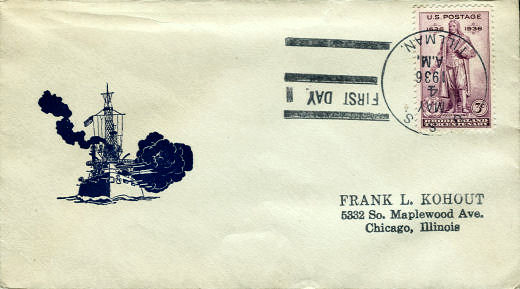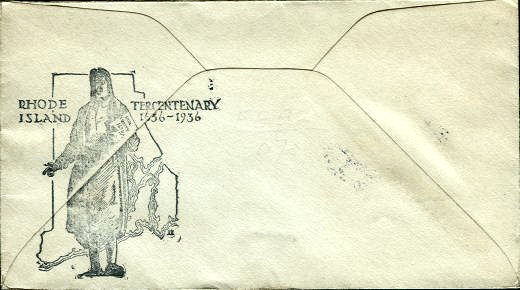![]()
Postal History Introduction
Stampless
Covers
1846
to 1900 Issues
1901-1950
Issues
1951-2003
Issues
Cancels
&
Miscellaneous
Postal
Stationery
Post
Cards
Air
Mail
First
Day &
Event Covers
Parcel Post/Special Delivery
Registered & Official Mail
Commercial & Advertising
Revenue & Postage Due
Wildlife & Game Issues
Complete List of RI Issues
|
Rhode Island Tercentenary Issue
First Day Cover |
|
|
|
|
Unofficial Cancel - USS Tillman DD 641 |
|
|
|
|
The second USS Tillman was named after Benjamin Ryan Tillman. He was born on August 11, 1847 in Edgefield County, S.C. In July 1864, Tillman left school to enter the Confederate Army, but his service to the South during the Civil War was prevented by serious illness. He served as governor of South Carolina from 1890 to 1894; and, during his administration, he founded Clemson Agricultural and Mechanical College. He entered the United States Senate on March 4, 1895, and held the position of senator for the remainder of his life. During World War I, Tillman was chairman of the Senate Committee on Naval Affairs until his death on July 3, 1918. The USS Tillman (DD-641) was launched on December 20, 1941 at the Charleston Navy Yard. The ship was sponsored by Mrs. Charles Sumner Moore and commissioned on June 4, 1942 under the command of Lieutenant Commander Francis Douglas McCorkle. From June until September 1942, Tillman underwent sea trials and shakedown off the east coast. In September and October, the new destroyer escorted convoys and participated in exercises on the Eastern Sea Frontier before getting underway on October 23 from Chesapeake Bay with a convoy bound for "Operation Torch," the invasion of North Africa. Shortly before midnight on November 7th, Tillman reached a point some six miles off the coast of Africa and began screening the unloading transports of the Center Attack Group during the successful assault on Fedhala. While screening off the transport area, Tillman engaged an enemy patrol vessel, W-83, which had attempted to slip six merchant ships into the transport area despite the destroyer's warnings. After coming under fire from Tillman's five-inch guns, the patrol vessel exploded and beached. Tillman later captured three French merchantmen. On November 10th, American troops advancing on Casablanca from the east came under fire from enemy destroyers. Tillman, Augusta (CA-31), and Edison (DD-439) attacked the enemy ships, at the same time drawing fire from the shore batteries including that at El Hank. Maneuvering at speeds up to 34 knots, Tillman fired on the enemy ships, leaving one vessel steaming in circles, before she returned to her station off the transport area. On November 12th, Tillman departed the area escorting a convoy which weathered 50 to 60 foot seas before arriving safely at New York on December 1. Tillman continued convoy duty in the wintry Atlantic and then participated in exercises off Casco Bay, Maine. Departing New York harbor in the early hours of February 8, 1943, a dark night with unusually strong tides, Tillman sideswiped the paravane boom of an improperly illuminated merchant vessel anchored directly in the channel. After repairs at New York, Tillman operated on the Eastern Sea Frontier through February and March, performing escort duties and participating in exercises. During the months of April through June, Tillman ran convoys in the Atlantic and Mediterranean. On July 5, she screened the sortie from Oran of a convoy bound for Operation "Husky," the invasion of Sicily. In the days that followed, the destroyer provided neutralizing fire on beach defenses and picked off artillery which menaced troops landing near Scoglitti. Before dawn on July 10, Tillman fired her first salvo into Yellow Beach at 0331, as the assault got underway. At 0430, a stick of six bombs dropped by enemy aircraft exploded 300 yards off Tillman's starboard bow, temporarily knocking out her radar. An hour later, Tillman silenced a shore battery which had been firing on Yellow Beach. Enemy air attackers, flying in low over the land where they were indiscernible by radar, harassed landing troops and supporting ships. Fear of hitting troops on the beaches forced the Allied ships to withhold their fire when aiming at the low-flying planes. During the night of July 10-11, Tillman patrolled off the invasion beaches. On the llth, she repelled enemy air bombing attacks and supplied fire missions called in by shore observers. On July 15 Tillman returned to Oran to guard returning transports. During the remainder of 1943, Tillman escorted convoys in Mediterranean and Atlantic waters, experiencing many dangerous moments as she protected vulnerable merchant vessels from enemy submarines and airplanes. While enroute from New York to Bizerte on September 2, 1943 after passing through the Strait of Gibraltar; Tillman was attacked by a German torpedo plane. Patchy haze limited visibility to 2,000 yards when the plane, incorrectly identified as friendly, dropped torpedoes. Quick maneuvering saved Tillman from destruction by the torpedo which crossed about 30 yards ahead and passed down her port side. During the same attack, Kendrick (DD-612) was damaged by a German torpedo. Two days later, the convoy arrived at Bizerte, but the illusion of safety in port was dispelled on 6 September by a 30-minute air attack on the harbor. Tillman engaged the attackers with her main battery and machine guns. Thirteen members of her crew were injured when a spent shell exploded on the deck of the ship. On November 6, 1943, as she steamed off the coast of Algeria, Tillman helped repel a German air attack on the port quarter of a convoy carrying troops and supplies for the Italian campaign. An estimated 25 German aircraft, many equipped with glider-bombs, took part in the raid, and sank two merchantmen and the destroyer Beatty (DD-640). In the first wave of the attack, a Dornier 217 singled out Tillman as the target of her glider-bomb. The radio-controlled missile came in at a terrific speed, but Tillman's machine guns splashed it in a violent explosion only 150 yards off the destroyer's port bow. Soon after, a second glider intended for Tillman's destruction splashed and exploded only 150 yards away, as Tillman shot down its launching plane. A third glider splashed off the ship's starboard beam as its parent craft turned back in the face of Tillman's concerted fire. During this first stage of the attack, Tillman maneuvered constantly and rapidly to evade the gliders. Her own safety temporarily secured, Tillman then turned her guns on planes attacking the convoy and splashed another attacker. Soon, the final and fiercest phase of the attack began as five German planes attacked Tillman. As her main battery engaged the raiders, Tillman turned left full rudder to evade torpedoes, two of which passed nearly parallel to the ship at distances of 60 and 100 feet. Moments later, as the destroyer swung to port to regain her station, a heavy explosion shook the ship. This detonation, thought to have been caused by a torpedo exploding in the destroyer's wake, caused her no serious damage; and she turned to the task of rescuing survivors from the sinking merchant freighter SS Santa Elena. She then proceeded to Philippeville to disembark the survivors. During December of 1943 and throughout 1944; Tillman escorted convoys between ports in the United States, the Mediterranean, and the United Kingdom. Occasionally, she varied this duty with overhaul at New York or exercises off New England. In the first three months of 1945, Tillman participated in exercises in the Caribbean and off the east coast before departing on March 28 from Delaware Bay and steaming via the Canal Zone and San Diego for Hawaii. Following her arrival at Pearl Harbor on April 21, she took part in exercises in Hawaiian waters, then departed the area on May 1st. Until September, Tillman performed life guard and antisubmarine picket duties out of Guam and Ulithi. On September 5 at Tamil Harbor; the commanding officer of the Japanese garrison on Yap Island formally surrendered to the American Atoll Commander from Ulithi on board Tillman. Tillman continued to operate in the Caroline Islands and southern Marianas until November 3, 1945 when she steamed for Charleston, SC via Pearl Harbor and the Panama Canal; arriving at Charleston on December 11, 1945 for deactivation. Tillman was decomissioned on February 6, 1947 and was struck from the Navy list in March 1972. Tillman earned three battle stars for her World War II service Source: Naval Historical Center - Dictionary of American Naval Fighting Ships |
![]()
RI Historical Society
The Post Offices
Home Page
RI Tercentenary Issue History
RI Philatelic Society
Recently Added Pages
Philatelic Primer
Rhode Island Around the World
Rhode Island
Town Postmarks
Other Websites of Interest
Return to
Tercentenary Thumbnail Page 6
OR
Return
to Ship Cancellations
Thumbnail Page Part 2

